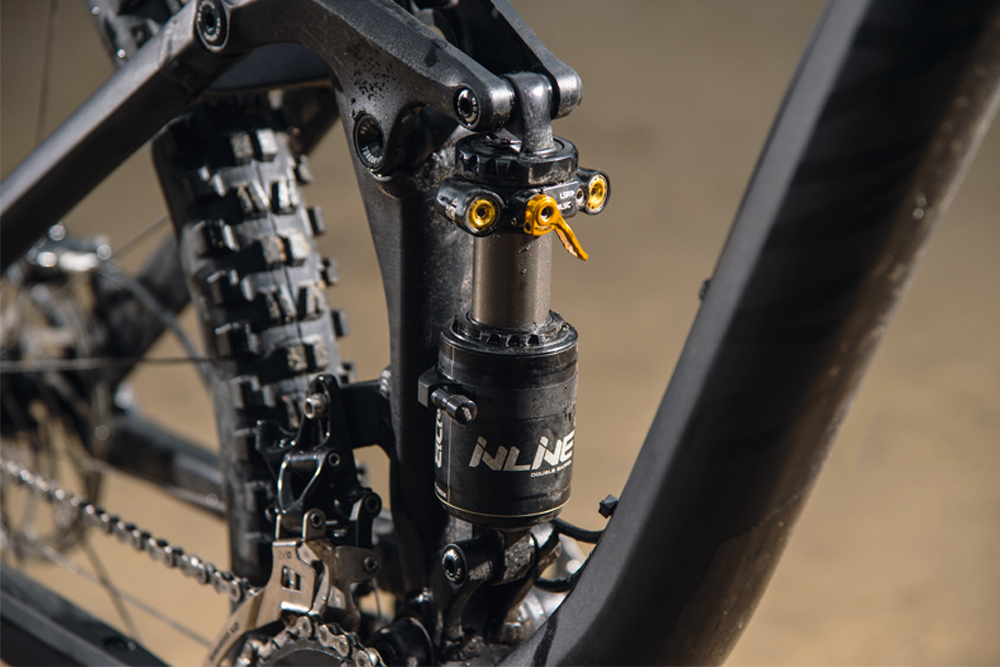After a lacklustre introduction, there was a suspicous transformation in performance with our Canyon Spectral. But what was it?
Canyon Spectral AL 9.9 (2015) review
Canyon is a direct-sales brand, which means you buy the bike from a website rather than walking into a shop. It’s based in Germany, the bikes are manufactured in Asia, but all the prices are quoted in sterling and it delivers directly to your door — although that costs an extra £48. By cutting out the middleman and reducing overheads, Canyon can pass significant savings on to its customers.
Hardly surprising then, that the Canyon Spectral AL 9.9 (2015) is one of the best dressed bikes in this test. The frame is only aluminium — not carbon, like the Cube — but at 14.34kg (31.61lb) it’s not a lot heavier and the build quality is exceptional. There are, however, a couple of little things we don’t like — there is no QR lever on the 142x12mm rear axle, so you need a tool to remove it. It’s also tricky to locate in the dropouts because the alignment isn’t spot on, and the Allen key often got wedged in the end of the axle. We also had problems with chain suck and chain derailments. Which is strange, as the Spectral Al 9.9 gets an E168 chain tensioner — similar to the Specialized’s Dangler — that’s supposed to stop this happening.
Suspension
To control the 130mm of rear travel, the Canyon comes fitted with Cane Creek’s new DBinline air shock. It essentially has the same double barrel design, and fully independent damping adjustments, as the regular DBair but without the piggy-back reservoir, allowing it to be squeezed into a wider variety of frame designs.
To make set-up easier, there is a base tune for the Spectral Al 9.9 listed on the Cane Creek website, as well as a recommended sag setting. Even with these dialed in the Spectral Al 9.9’s suspension tended to cycle too easily around the mid-stroke, but unlike the Stumpy Evo it isn’t lively and there’s not as much grip or pop. It gets particularly animated when climbing, so we were happy to see the Climb Switch on top of the DBinline as it has a really calming effect on the bike. In fact, we used it quite a bit on flatter, technical trails just because it added some much-needed stability.
Components
It’s great to get a Reverb Stealth seatpost on a £2.5k bike, but the one on the Spectral Al 9.9 only has 100mm drop, rather than the more common 125mm. The upshot being that the saddle smacked us in the chest on steep descents. We also found the 70mm stem a touch long and, while Canyon says you can go shorter, it doesn’t offer that option when purchasing the bike. It does, however, let you swap the Ergon SME30 saddle for a women’s Vitesse at no extra charge.
Tubeless-ready DT Swiss XM1501 wheels come fitted with fast-rolling Continental tyres. They are 2.4in, though, and will result in a higher bottom bracket than we measured with our Maxxis control tyres fitted.
Performance
We spent six weeks testing the Spectral Al 9.9 in the Surrey Hills, and in that time we thought it was competent but uninspiring. The first run at Bike Park Wales, though, had us scratching our heads, because it suddenly felt amazing; railing corners, flying off jumps, even hammering through rock gardens. We were pushing it so hard it was the only bike we pinch-flatted that day.
It felt so different to our previous experience that we decided to double-check the geometry, and it soon became clear something had changed. The BB was 20mm lower and the head angle was two degrees slacker. How could that be? For some reason the Cane Creek shock had stuck down and we’d lost 10mm from the stroke. It doesn’t sound like a big difference but it resulted in massive changes to the geometry and handling. Obviously the shock is covered under warranty, and we have since fitted a replacement, with no further issue. But we were back to square one with the handling.
>>> Click here to find out more about geometry with our handy guide
Verdict
What’s telling about riding the Spectral Al 9.9, with a stuck-down shock and non-standard geometry, is how the bike felt much more stable at speed. Granted, the rear suspension didn’t work anything like as well as it did with a fully functioning shock, but the extra stability meant that we weren’t always having to compensate for the overly soft rear suspension. It’s a similar story on other Canyon Spectrals we’ve tested, and it just seems to be a peculiarity of the suspension design. It’s frustrating to say the least, especially given that the rest of the bike is top-notch.





















